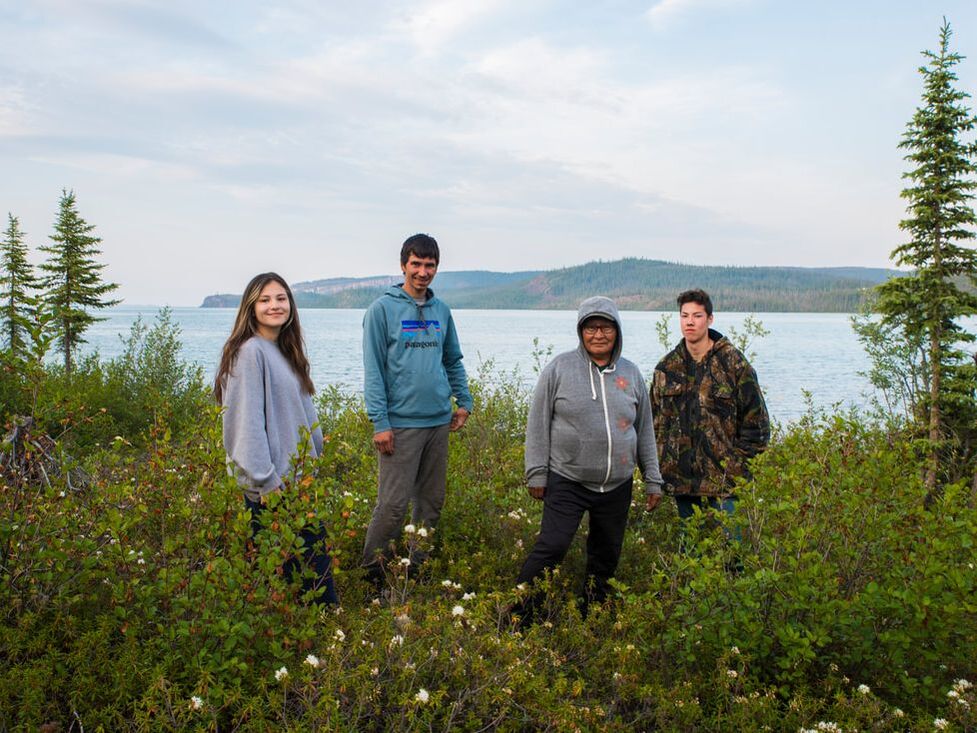|
This is part of a series of profiles about the staff, leaders, and community members who are hard at work implementing Łutsël K’é Dene First Nation's vision for the Thaidene Nëné Indigenous Protected Area. You can read the other profiles here.  Terri Enzoe was born on hazú (the barrenlands). Her parents, Elizabeth (Nitah) Enzoe and Billy Enzoe, named their daughter Doris (pronounced Door-ass), the Dënesųłıné version of Terese. Later, travelling by canoe, the family moved to Reliance, where there was a trading post, then eventually to Snowdrift as Łutsël K’é was then known. In the fall time, the family would relocate to the bush to trap and harvest, returning to the community at Christmas. The rest of the year, Billy Enzoe did odd jobs. Terri was raised with a foot in two worlds, though her heart is on the tundra. Today, Terri, who lives in Łutsël K’é with her partner Andy, takes every opportunity to be out on the land, most often travelling with her son, Kyle, who she describes as “made for the bush.” (Terri is mother to three other children and grandmother to six.) When she’s in town, Terri can be found fixing meat, tanning hides, and sewing—her expertly crafted designs are available through Caribou People Creations. Terri was a familiar face at the community meetings that were critical to the establishment of Thaidene Nëné. When she thinks about Thaidene Nëné, Terri recalls those meetings and the elders’ commitment to protecting the land for younger generations. “The elders knew that development was coming and that it might destroy our water and our animals,” Terri says. The elders called the area of land they wanted to protect, Thaidene Nëné. “Thaidene means long time ago, the old timers,” Terri explains. “Thaidene Nëné is where our ancestors used to live long time ago.” It was Terri’s sister, Gloria Enzoe (now Shearing), who started Ni Hat’ni Dene, which means “watchers of the land” in Dënesųłıné, in 2008. Terri and her son, Kyle, applied because they were looking for a man and a woman to serve as guardians. Terri saw the utility in that approach: “That way you can bring young girls and young men out, to teach them both how to live off the land.” Over ten summers, Terri worked closely with young women and men from the community, sharing her knowledge of how to live on the land, but also Dënesųłıné language and culture. She recalls, “We showed them spiritual places, burial sites, the places where our ancestors used to live. We showed them where you have to be quiet, where you have to pay the water. We showed them that this is a good place for stopping when it’s windy. This is a good place for fishing. And we’d tell them how it used to be long time ago.” Terri has many stories from the decade that she spent travelling the land and water with Ni Hat’ni Dene. There was the time, for instance, they were winded for five days at the Ni Hat’ni cabin at Talthelie Narrows. Terri, Kyle, and the four summer interns busied themselves setting and pulling a net for fish sampling. Together the group processed 17 trout and 67 jumbo whitefish. Just as they finished, they turned around and there was a moose. After fixing the meat, the group travelled back to town. “I went to the store and told everyone, ‘There’s lots of fish, lots of moose.’ I spent the rest of the day giving away fish and meat,” Terri remembers with a big grin. Today, Terri is a member of the Łutsël K’é Dene First Nation council and Sub-Chief of the community. In that capacity, she is supporting and helping to guide Łutsël K’é’s work in Thaidene Nëné. Terri believes strongly that the success of Thaidene Nëné is directly related to youth: “We have to motivate our young people. We have to tell them how we used to live and how we’re going to live today. The life cycle has all changed now—it’s so different—but we still have to keep our old ways of living if we want to keep Thaidene Nëné.” This sharing of knowledge is critical to the future of the Indigenous protected area. Terri likens the way forward to a path: “If you follow those footprints, it will go on to the next generation and the ones after that. If you don’t, it stops there. The path ends. Then there’s no Thaidene Nëné.” Comments are closed.
|
AuthorWrite something about yourself. No need to be fancy, just an overview. Archives
July 2024
Categories |
CONNECT |
VISIONWe are the Lutsel K’e Dene First Nation. Our vision for Thaidene Nëné is:
Nuwe néné, nuwe ch'anıé yunedhé xa (Our land, our culture for the future). We’re working with our partners to permanently protect Thaidene Nëné—part of our huge and bountiful homeland around and beyond the East Arm of Tu Nedhé. |
